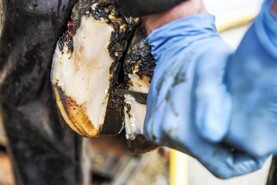The latest animal identification and movement (AIM) data available from the Department of Agriculture shows the national cattle herd standing at 7.23m head on 1 April. This is a reduction of 114,341 head on levels recorded on 1 April 2023.
The latest figures paint a different picture than in recent years, with the number of dairy-sired animals on farms reducing by 142,835 head.
The greatest percentage amounting to some 60% (85,743 head) were dairy males, with just shy of 60,000 head of the reduction recorded in the 12- to 18-month age bracket.
This is a consequence of a combination of strong live exports of calves in 2023 and greater use of beef genetics in dairy breeding programmes, with sexed semen also playing a role.
The increased use of beef genetics is also evident in the number of dairy heifers in the same age bracket running over 31,000 head lower-year on year.
This trend is continuing, with the number of dairy males in the zero- to three-month age bracket running almost 15,000 head lower, while the number of dairy females dipped by 13,142 head.
In contrast, the number of beef males and females of equivalent age increased by 22,586 head and 22,201 head respectively.
Suckler decline
It is clear that these figures have not been driven by suckler births, with the national suckler herd continuing to worryingly trend in the wrong direction.
The AIM data shows 45,451 fewer suckler cows on farms compared with 12 months previous.
Dairy figures
Getting back to dairy figures, the reduction of over 52,000 heifers aged zero to 18 months of age is the first time in over a decade that dairy females have declined so significantly.
It is an indication that uncertainties surrounding factors such as Ireland’s nitrates derogation, more stringent farm policies, tight labour availability and tighter margins may be quelling growth in the national herd.
The consequences of extremely challenging weather conditions is also manifesting in higher culling of dairy cows in 2024, with over 23,500 more dairy cows culled. This is feeding in to 15,567 fewer dairy cows recorded on farms on 1 April.
Looking at short and longer-term cattle supplies there were 8,630 more beef females in the 24 to 30 month age bracket with this largely cancelled out by 4,702 less dairy males and 2,752 less beef males.
As detailed in Figure 1, there were 5,334 fewer cattle aged 18 to 24 months while the sharp reduction in dairy males aged 12 to 18 months is being cancelled out by an increase in beef males and females.






 This is a subscriber-only article
This is a subscriber-only article










SHARING OPTIONS: